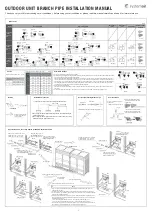
6 Installation
Installer reference guide
14
FDXM25~60F3V1B(9)
Split system air conditioners
4P550955-1 – 2018.07
WARNING: FLAMMABLE MATERIAL
The R32 refrigerant (if applicable) in this unit is mildly
flammable. Refer to the outdoor unit specifications for the
type of refrigerant to be used.
▪
Pipe length
. Keep refrigerant piping as short as possible.
▪
Flare connections
. Connect refrigerant piping to the unit using
flare connections.
▪
Insulation
. Insulate the refrigerant piping on the indoor unit as
follows:
A
B
a
d
c
e f
b
b
a
d
c
e f
b
b
2
4
3
g
1
2
3
4
g
A
B
1
A
Gas piping
B
Liquid piping
a
Insulation material (field supply)
b
Cable tie (accessory)
c
Insulation pieces: Large (gas pipe), small (liquid pipe)
(accessories)
d
Flare nut (attached to the unit)
e
Refrigerant pipe connection (attached to the unit)
f
Unit
g
Sealing pads: Medium 1 (gas pipe), medium 2 (liquid pipe)
(accessories)
1
Turn up the seams of the insulation pieces.
2
Attach to the base of the unit.
3
Tighten the cable ties on the insulation pieces.
4
Wrap the sealing pad from the base of the unit to the top of
the flare nut.
NOTICE
Make sure to insulate all refrigerant piping. Any exposed
piping might cause condensation.
6.3.7
To check for leaks
NOTICE
Do NOT exceed the unit's maximum working pressure (see
"PS High" on the unit name plate).
NOTICE
Make sure to use a recommended bubble test solution
from your wholesaler. Do not use soap water, which may
cause cracking of flare nuts (soap water may contain salt,
which absorbs moisture that will freeze when the piping
gets cold), and/or lead to corrosion of flared joints (soap
water may contain ammonia which causes a corrosive
effect between the brass flare nut and the copper flare).
1
Charge the system with nitrogen gas up to a gauge pressure of
at least 200 kPa (2 bar). It is recommended to pressurize to
3000 kPa (30 bar) in order to detect small leaks.
2
Check for leaks by applying the bubble test solution to all
connections.
3
Discharge all nitrogen gas.
6.4
Connecting the electrical wiring
6.4.1
About connecting the electrical wiring
Typical workflow
Connecting the electrical wiring typically consists of the following
stages:
1
Making sure the power supply system complies with the
electrical specifications of the units.
2
Connecting the electrical wiring to the outdoor unit.
3
Connecting the electrical wiring to the indoor unit.
4
Connecting the main power supply.
6.4.2
Precautions when connecting the
electrical wiring
INFORMATION
Also read the precautions and requirements in the
following chapters:
▪ General safety precautions
▪ Preparation
DANGER: RISK OF ELECTROCUTION
WARNING
ALWAYS use multicore cable for power supply cables.
WARNING
If the supply cord is damaged, it MUST be replaced by the
manufacturer, its service agent or similarly qualified
persons in order to avoid a hazard.
6.4.3
Guidelines when connecting the electrical
wiring
Keep the following in mind:
▪ If stranded conductor wires are used, install a round crimp-style
terminal on the end of the wire. Place the round crimp-style
terminal on the wire up to the covered part and fasten the terminal
with the appropriate tool.
b
a
a
Stranded conductor wire
b
Round crimp-style terminal
▪ Use the following methods for installing wires:
Wire type
Installation method
Single-core wire
c b
c
a
a
A
AA´
A´
a
Curled single-core wire
b
Screw
c
Flat washer






































